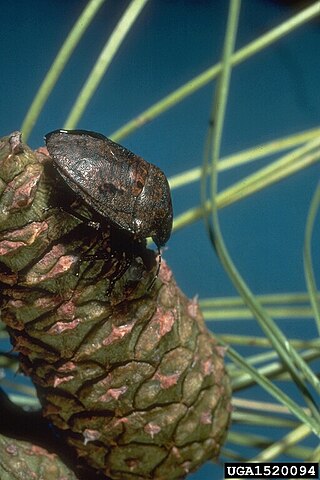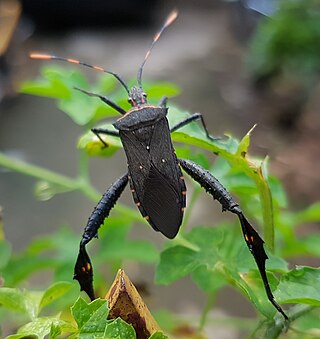
Scutelleridae is a family of true bugs. They are commonly known as jewel bugs or metallic shield bugs due to their often brilliant coloration. With the name based on the Asian genus Scutellera, they are also known as shield-backed bugs due to the enlargement of the thoracic scutellum into a continuous shield over the abdomen and wings. This latter characteristic distinguishes them from most other families within Heteroptera, and may lead to misidentification as a beetle rather than a bug. These insects feed on plant juices from a variety of different species, including some commercial crops. Closely related to stink bugs, they may also produce an offensive odour when disturbed. There are around 450 species worldwide.

The least tern is a species of tern that breeds in North America and locally in northern South America. It is closely related to, and was formerly often considered conspecific with, the little tern of the Old World. Other close relatives include the yellow-billed tern and Peruvian tern, both from South America.

Zombia antillarum, commonly known as the zombie palm, is a species of palm tree and the only member of the genus Zombia. It is endemic to the island of Hispaniola in the Greater Antilles. Usually found in dry, hilly areas of northern and southern Haiti and the northwest of the Dominican Republic, Z. antillarum is a relatively short fan palm with clustered stems and a very distinctive appearance caused by its persistent spiny leaf sheaths. Threatened by habitat destruction in Haiti, Z. antillarum is a popular ornamental species due to its distinctive appearance, low maintenance requirements and salt tolerance.

Oryzomys antillarum, also known as the Jamaican rice rat, is an extinct rodent of Jamaica. A member of the genus Oryzomys within the family Cricetidae, it is similar to O. couesi of mainland Central America, from where it may have dispersed to its island during the last glacial period. O. antillarum is common in subfossil cave faunas and is also known from three specimens collected live in the 19th century. Some historical records of Jamaican rats may pertain to it. The species probably became extinct late in the 19th century, perhaps due to the introduction of the small Indian mongoose, competition with introduced rodents such as the brown rat, and habitat destruction.
Elephantomyia westwoodi is a species of limoniid crane fly in the family Limoniidae.

Epierus is a genus of clown beetles in the family Histeridae. There are more than 50 described species in Epierus.
Tetyra robusta is a species of shield-backed bug in the family Scutelleridae. It is found in Central America and North America.

Tetyra is a genus of shield-backed bugs in the family Scutelleridae. There are about seven described species in Tetyra.

Neurocolpus nubilus, the clouded plant bug, is a species of plant bug in the family Miridae. It is found in North America.

Anasa armigera, the horned squash bug, is a species of leaf-footed bug in the family Coreidae. It is found in North America.
Aradus funestus is a species of flat bug in the family Aradidae. It is found in North America.
Pilophorus tibialis is a species of plant bug in the family Miridae. It is found in Central America and North America.

Chelinidea vittiger, known generally as cactus coreid, is a species of leaf-footed bug in the family Coreidae. Other common names include the squash bug and cactus bug. It is found in Australia, Central America, and North America.
Aradus depictus is a species of flat bug in the family Aradidae. It is found in North America.
Paroxacis is a genus of false blister beetles in the family Oedemeridae. There are about five described species in Paroxacis.

Belotus is a genus of soldier beetles in the family Cantharidae. There are at least four described species in Belotus.
Plagiognathus brunneus is a species of plant bug in the family Miridae. It is found in North America.
Plagiognathus albatus is a species of plant bug in the family Miridae. It is found in North America.

Tetyra bipunctata, the shieldbacked pine seed bug, is a species of shield-backed bug in the family Scutelleridae. It is found in Central America and North America.

Leptoglossus gonagra, known as the passionvine bug, citron bug or squash bug in different parts of its range, is a species of leaf-footed bug in the family Coreidae. It is found in Africa, the Caribbean, Central America, North America, South America, Southern Asia, the Pacific Ocean and Oceania.










